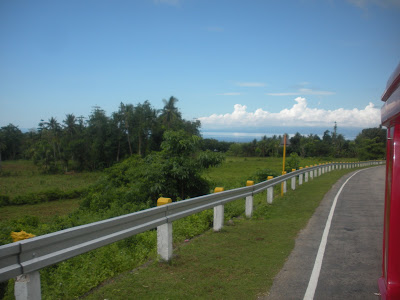These are not Siquijor’s popular spots. In fact, they are just ordinary road scenes on the island but nonetheless they are equally important because they also tell us about Siquijor.
Pit Stop First Before The Trip.
Our multi-cab driver had to gas up before we begin our four-hour road trip of the island. We stopped by a store that sells gasoline and diesel in one-liter soft drink bottles. For a minute you would think that it’s an ordinary sari-sari store selling soft drinks, but this one is actually selling gas in “tingi-tingi”.
 For a while we forgot that we were in a Cebuano-speaking territory. This sign got lost in translation, raised several eyebrows and elicited jokes and laughs from my companions, all Ilonggos. Sabut in Ilonggo means pubic hair, by the way.
For a while we forgot that we were in a Cebuano-speaking territory. This sign got lost in translation, raised several eyebrows and elicited jokes and laughs from my companions, all Ilonggos. Sabut in Ilonggo means pubic hair, by the way.
The Road.
Sometimes our vehicle would slow down. It would give me just enough time to snap pictures of where we had been...
...or of what's on the side of the road...
 |
| At first, we thought this was a fortified watchtower. Our guide told us that this was a concrete water reservoir. I think the household uses it to catch rainwater, too. |
...and of what lies ahead of us.
 |
| We stopped by this spot for a few minutes to have a good scenic view of the island’s coast and the inviting deep, blue sea. |
The roads are mostly paved with concrete and asphalt, and at the time of our trip it was undergoing rehabilitation and construction.
A good infrastructure augurs well for a worthwhile road trip.
The roads are well-maintained by the Department of Public Works and Highways. It’s nice to see DPWH billboards without names of EPALS on it.
The Old Houses.
An interesting thing to notice about Siquijor is its houses. Anywhere you go you'll see wooden houses. Seldom can you find houses made out of bamboo, even how small.
 |
| Typical houses in Siquijor are made of wood. Their walls are made up of hardwood planks. |
One can easily see that most of the wooden houses are quite old, with walls deprived of any paint to mask the shabby appearance of these humble abodes. Yet altogether these houses show a certain character that is so typical of the island: simple but enduring.
And speaking of enduring, the picture below is reputed to be the oldest house in all of Siquijor. It is said to be over a century old and is still inhabited, of course. Overall, our four-hour road trip was "bitin" because we didn't get to see the other places that we would have love to visit. Maybe next time.













No comments:
Post a Comment